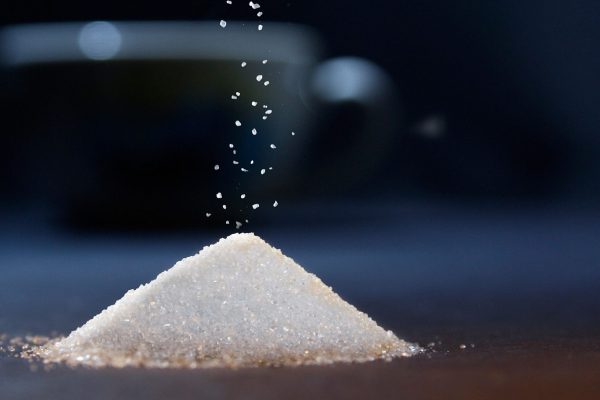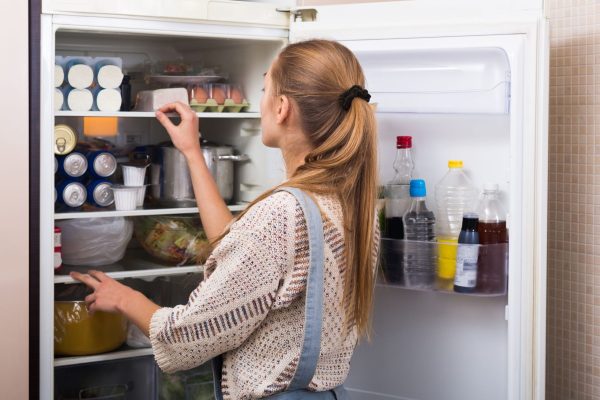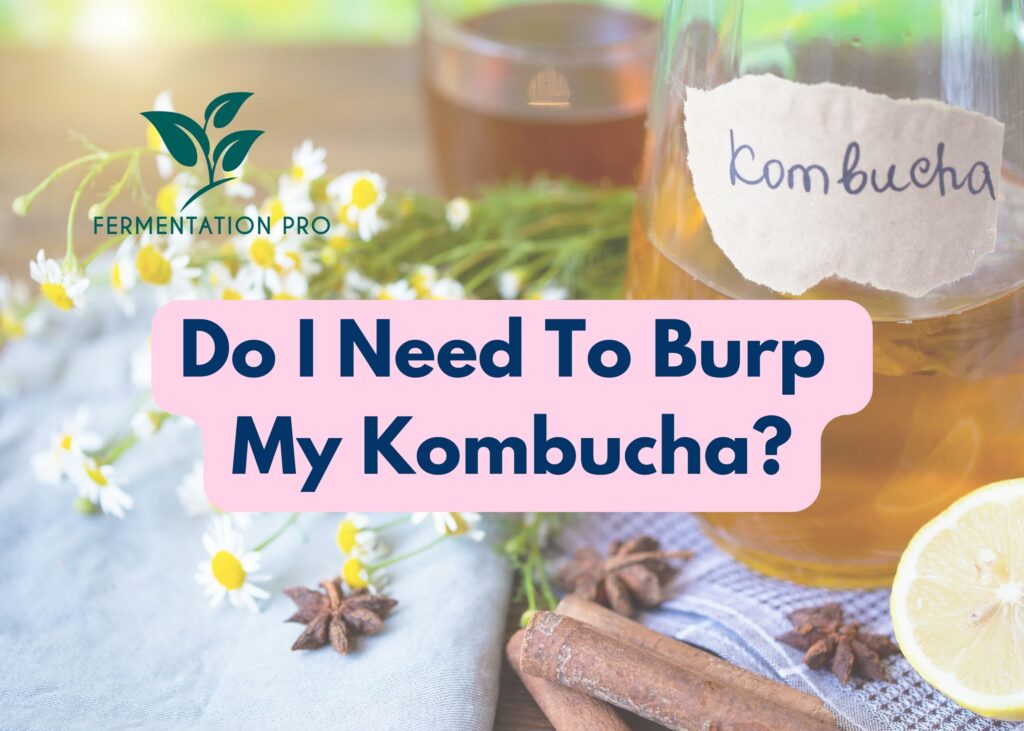Many Kombucha brewers continue to argue whether you should burp your Kombucha or not which confuses many newbie homebrewers. If you are one of the newbie brewers still looking for an answer to the question “Do I need to burp my Kombucha?”, this post is for you.
So, is burping Kombucha necessary? The truth is, the answer can be yes or no. If you are brewing Kombucha for 3 days only, then you do not need to burp your Kombucha. All you need to do is leave it alone so it develops sufficient carbonation. Burping Kombucha that only ferments for less than 3 days can interfere with the carbonation buildup resulting in a flat Kombucha. On the other hand, if you are brewing it for 3 days and more, you’ll have to burp your Kombucha once daily or every other day after 3 days of fermentation to release the excess carbon dioxide in the Kombucha.
Homebrewing Kombucha is generally easy and safe. However, accidents are inevitable especially if your Kombucha has too much pressure inside or has turned into a Kombucha bomb. Hence, it is important to burp Kombucha and pay careful attention to the other important details of fermenting this healthy beverage.
Table of Contents
Kombucha Bomb
As you ferment your bottled Kombucha, the yeast feeds on the sugar and creates carbon dioxide or CO2. CO2 is an essential gas for the carbonation of Kombucha during the second fermentation. Bottled Kombuchas are sealed so that the CO2 has no way to escape. This forces it to dissolve right into the Kombucha liquid giving the Kombucha liquid its effervescence.
When the bottled Kombucha continues to ferment for a longer time, the yeast also produces more CO2 leading to pressure buildup inside the bottle. When there is too much pressure inside the bottle, Kombucha bombs or explosions happen. This doesn’t just make a huge mess in your kitchen but also causes most, if not all, of your Kombucha to go to waste. The bottle may also break due to the explosion and cause potential injuries.
Kombucha bombs can be scary but, don’t overthink because there are several ways to prevent them. Below, we’ve discussed these ways one by one.
How To Prevent Kombucha Bombs

1. Burp the Kombucha
Burping Kombucha is the best way to prevent Kombucha bombs when brewing bottled Kombucha for more than 3 days. Depending on the fermentation progress, you can burp your Kombucha once every day or every other day after 3 days of fermentation.
To burp Kombucha, simply open the bottles slightly, allowing the excess carbon dioxide to get out of the bottle. Only do this for a few seconds and immediately seal it tightly again. Take note to never open your bottled Kombucha too much or too often as it may cause it to lose all its carbonation buildup and go flat.
If you are only brewing Kombucha for 3 days, burping is unnecessary as it can only affect the carbonation buildup and prevent Kombucha from achieving sufficient carbonation.
2. Use high-quality bottles
In addition to pressure, the quality of the bottles used in fermentation may also increase the risks of Kombucha bombs. Low-quality glass bottles often can’t handle too much carbon dioxide pressure. Hence, we always recommend investing in high-quality bottles preferably bottles of about 58 psi or thicker.
Fundamentally, the thicker the bottles are, the stronger they are at containing pressure. In addition to the bottles, we also suggest considering the caps. We recommend using thick glass bottles with swing-top resealable caps as they can open slightly when the pressure buildup is too much.
3. Avoid adding too much sugar and flavoring to your bottled kombucha
Feeding your yeast too much sugar makes them very active. Hence, they can produce more carbon dioxide that can cause pressure buildup inside the bottle. Take note to only add ½ to 1 tsp. sugar per 16 oz. bottle.
In addition to sugar, you should also limit the amount of flavorings in your bottled Kombucha as they may contain natural sugars that can also boost yeast activity. We suggest only adding 5% to 20% flavoring only per bottle.
4. Strain the extra yeast
Before bottling, you may strain the extra yeast with a strainer or coffee filter. Reducing the amount of yeast in your bottled Kombuchas prevents the quick buildup of carbon dioxide inside the bottles.
5. Store your bottled kombucha in enclosed spaces
If you are brewing at a high temperature, keeping your bottled Kombucha in an enclosed space is a good measure to prevent a mess in case a Kombucha does explode. kombuchakamp.com suggest places like boxes, cooler, or cabinets as storage for bottled Kombuchas.

How To Handle Kombucha Bombs
If you think that you have a potential Kombucha bomb in your kitchen, here are some things you can do.
1. Keep the bottled Kombucha in a cold storage
The cold temperature inhibits the yeast activity so you can prevent the yeast from creating more carbon dioxide. In addition, it will dampen carbon dioxide minimizing the pressure inside the bottle, Make sure to store it at a temperature that is slightly over the freezing temperature for up to 4 hours before opening it.
2. Place the bottled kombucha in a strong container that can contain all the mess
If you think that a cold temperature is not enough to stop your Kombucha from exploding, you can place it in a strong container like a metal bin to prevent the liquid and glass fragments from causing a mess and potential hazards. Remember to protect yourself as you hold the bottle and place it in the container. You can wear protective gear like goggles, gloves, face shields, and more.
3. Place the bottled Kombucha in a thick plastic bag
Want to save your Kombucha liquid? If yes, this trick may help you. Simply place the bottled Kombucha in a thick plastic bag with its mouth facing down. Next, remove the cap and hold the plastic firmly. Don’t forget to wear safety gear to avoid getting hurt in case the Kombucha suddenly explodes.
4. Wrap the bottle with thick towels and open the bottle in the sink
If you are using a thick bottle that is not prone to breaking, this trick is a convenient solution. Simply wrap the Kombucha bottle with a thick towel and place it on the sink. Next, unscrew the cap and let the liquid out. This way is safe but it will cause a mess in your sink.
Do You Need To Burp Kombucha In The Fridge?

The short answer is no. If you’ve already transferred your bottled Kombucha to the fridge because its taste is already suitable for you. You won’t need to continue burping it because the cool temperature in the fridge will slow down its fermentation. Hence, the yeast’s activity becomes dormant and the production of carbon dioxide is also weaker than before. With weaker production of carbon dioxide, the chances of Kombucha bombs also become less.
Storing bottled Kombucha in the fridge is an excellent way to prevent Kombucha bombs. In addition to that, you can preserve your preferred Kombucha taste for a longer time. Unopened bottled kombuchas in the fridge usually last for one to three months.
How Do You Know When To Burp Kombucha?
It is difficult to know when is the best time to burp Kombucha. Generally, you’ll know that it’s time to burp the Kombucha by how many days it has fermented. Usually, it is best to start burping the Kombucha after three days of fermentation.
Apart from the number of fermentation days, you may also try tracking the carbonation buildup of the Kombucha by using a plastic bottle. To do this, simply fill a plastic bottle with Kombucha and check if it turns hard. When the plastic bottle hardens, it means that there is already enough carbon dioxide in Kombucha and you should start burping the bottles if you want to continue fermentation. If you don’t want to ferment the Kombucha further, you may transfer the Kombucha to the fridge to inhibit yeast activity and preserve the flavor.
Does Kombucha Need Airflow?
It depends on which fermentation process you are having. If it’s the first fermentation or F1 of Kombucha, your Kombucha will need airflow to ferment. F1 is an aerobic fermentation process. This means that it requires exposure to oxygen to jumpstart fermentation. The oxygen is necessary for the Acetic Acid Bacteria (AAB) in Kombucha to survive and grow. The AAB gives the Kombucha its distinct sour taste and high acidity which protects it from harmful contaminants and molds. In addition, it keeps the Kombucha less alcoholic. Without the AAB, Kombucha will not become tangy and will be prone to contamination. Hence, it is best to brew F1 Kombucha in a place with good ventilation to ensure proper fermentation.
When the Kombucha finishes F1, it undergoes second fermentation or F2. During F2, Kombucha will not need oxygen to carry on with the fermentation as the goal of this fermentation process is to flavor and carbonate Kombucha. This is a task mainly for the yeast. Unlike AAB, the yeast in Kombucha doesn’t need oxygen to survive. Due to the lack of oxygen in F2, the AAB becomes less active and the acidity of Kombucha decreases to a safe level and becomes less tangy. Furthermore, the Kombucha’s alcohol level can also go up. During F2, the Kombucha should be sealed tightly to prevent the carbonation from going out. The result is a less tangy and fizzy Kombucha with hints of different flavors.
Should I Stir Kombucha While It’s Fermenting?
Stirring your Kombucha while it’s fermenting doesn’t affect your brew’s fermentation process negatively. However, it may increase the risks of contamination. Hence, we suggest letting your Kombucha brew by itself and avoiding stirring it. The best time to stir your Kombucha is before bottling to distribute the yeast to the Kombucha liquid and achieve a consistent taste in the bottled Kombuchas.








